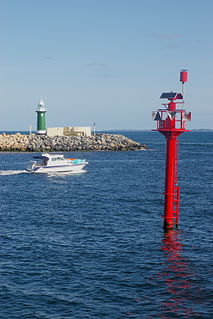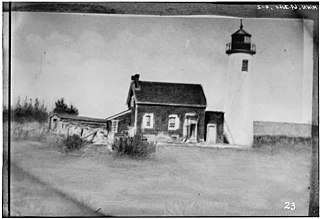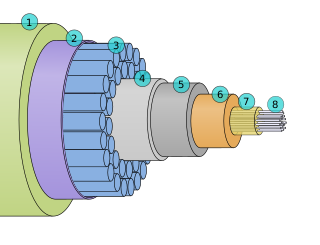
The Intracoastal Waterway (ICW) is a 3,000-mile (4,800 km) inland waterway along the Atlantic and Gulf of Mexico coasts of the United States, running from Boston, Massachusetts, southward along the Atlantic Seaboard and around the southern tip of Florida, then following the Gulf Coast to Brownsville, Texas. Some sections of the waterway consist of natural inlets, saltwater rivers, bays, and sounds, while others are artificial canals. It provides a navigable route along its length without many of the hazards of travel on the open sea.

A body of water, such as a river, canal or lake, is navigable if it is deep, wide and slow enough for a vessel to pass or walk. Preferably there are few obstructions such as rocks or trees to avoid. Bridges must have sufficient clearance. High water speed may make a channel unnavigable. Waters may be unnavigable because of ice, particularly in winter. Navigability depends on context: A small river may be navigable by smaller craft, such as a motorboat or a kayak, but unnavigable by a cruise ship. Shallow rivers may be made navigable by the installation of locks that increase and regulate water depth, or by dredging.

The Fifty-third United States Congress was a meeting of the legislative branch of the United States federal government, consisting of the United States Senate and the United States House of Representatives. It met in Washington, D.C. from March 4, 1893, to March 4, 1895, during the first two years of Grover Cleveland's second presidency. The apportionment of seats in the House of Representatives was based on the Eleventh Census of the United States in 1890. Both chambers had a Democratic majority.

The Sixtieth United States Congress was a meeting of the legislative branch of the United States federal government, composed of the United States Senate and the United States House of Representatives. It met in Washington, DC from March 4, 1907, to March 4, 1909, during the last two years of Theodore Roosevelt's presidency. The apportionment of seats in the House of Representatives was based on the Twelfth Census of the United States in 1900. Both chambers had a Republican majority.

The Fifty-fifth United States Congress was a meeting of the legislative branch of the United States federal government, composed of the United States Senate and the United States House of Representatives. It met in Washington, DC from March 4, 1897, to March 4, 1899, during the first two years of William McKinley's presidency. The apportionment of seats in the House of Representatives was based on the Eleventh Census of the United States in 1890. Both chambers had a Republican majority. There was one African-American member, George Henry White, a Republican from the state of North Carolina.

The Fifty-eighth United States Congress was a meeting of the legislative branch of the United States federal government, composed of the United States Senate and the United States House of Representatives. It met in Washington, DC, from March 4, 1903, to March 4, 1905, during the third and fourth years of Theodore Roosevelt's presidency. The apportionment of seats in the House of Representatives was based on the Twelfth Census of the United States in 1900. Both chambers had a Republican majority.

The United States Lighthouse Board was the second agency of the US Federal Government, under the Department of Treasury, responsible for the construction and maintenance of all lighthouses and navigation aids in the United States, between 1852 and 1910. The new agency was created following complaints of the shipping industry of the previous administration of lighthouses under the Treasury's Lighthouse Establishment, which had had jurisdiction since 1791, and since 1820, been under the control of Stephen Pleasonton. The quasi-military board first met on April 28, 1851 and with its establishment, the administration of lighthouses and other aids to navigation would take their largest leap toward modernization since the inception of federal government control. In 1910, the Lighthouse Board was disestablished in favor of a more civilian Lighthouse Service, under the Department of Commerce; later the Lighthouse Service was merged into the United States Coast Guard in 1939.
The Mount Vernon Conference was a meeting of delegates from Virginia and Maryland held March 21–28, 1785, to discuss navigational rights in the states' common waterways. On March 28, 1785, the group drew up a thirteen-point proposal to govern the two states' rights on the Potomac River, Pocomoke River, and Chesapeake Bay. Known as the Mount Vernon Compact, formally titled as the Compact of 1785, this agreement not only covered tidewater navigation but also extended to issues such as toll duties, commerce regulations, fishing rights, and debt collection. Ratified by the legislature of both states, the compact helped set a precedent for later meetings between states for discussions into areas of mutual concern.

The history of turnpikes and canals in the United States began with work attempted and accomplished in the original thirteen colonies, predicated on European technology. After gaining independence, the United States grew westward, crossing the Appalachian Mountains with the admission of new states and then doubling in size with the Louisiana Purchase in 1803. The only means of transportation at the time between the coastal states and interior lands remained on water, by canoe, boat and ship, or over land on foot and by pack animal. Recognizing the success of Roman roads in unifying that empire, political and business leaders in the United States began to construct roads and canals to connect the disparate parts of the nation.

Selkirk Lighthouse is located at mouth of the Salmon River in New York. It is one of only four lighthouses in the United States that retains its original bird-cage lantern.
Rivers and Harbors Act may refer to one of many pieces of legislation and appropriations passed by the United States Congress since the first such legislation in 1824. At that time Congress appropriated $75,000 to improve navigation on the Ohio and Mississippi rivers by removing sandbars, snags, and other obstacles. Like when first passed, the legislation was to be administered by the United States Army Corps of Engineers (USACE), under its Chief Engineer and the Secretary of War.
The United States House Committee on Territories was a committee of the United States House of Representatives from 1825 to 1946. Its jurisdiction was reporting on a variety to topics related to the territories, including legislation concerning them, and their admission as new states.
The United States House Committee on Roads and Canals was a U.S. House committee, which was initially established as a select committee in 1815 and subsequently became a standing committee between 1831 and 1869. Roads and canals were an initial and integral sector of domestic improvements for transportation. Previously from 1795 to 1815, federal government support for internal improvements was under the jurisdiction of the Committee on Commerce and Manufactures. Considered closely related to increasing the value of domestic commerce and funded by protective tariffs on it, the general subject of internal improvements was one of the most contentious issues in the young republic, despite the near-universal acceptance of the need for such development.
The General Survey Act was a law passed by the United States Congress in April 1824, which authorized the president to have surveys made of routes for transport roads and canals "of national importance, in a commercial or military point of view, or necessary for the transportation of public mail." While such infrastructure of national scope had been discussed and shown wanting for years, its passage shortly followed the landmark Supreme Court ruling, Gibbons v. Ogden, which first established federal authority over interstate commerce including navigation by river. The president assigned responsibility for the surveys to the Corps of Engineers (USACE).

The Minnesota Point Light was a historic lighthouse on Minnesota Point in Duluth, Minnesota, United States, on the shores of Lake Superior. Built in 1858, it was the first lighthouse in the state, but is now a truncated ruined tower. The ruin was listed on the National Register of Historic Places in 1974 for its state-level significance in the theme of transportation. It was nominated for being the first high-powered lighthouse on Lake Superior, and the zero-point for all original surveys of the lake.

The Racine Harbor Lighthouse and Life Saving Station is a complex of navigation aids begun by the U.S. government in the 1860s near the harbor of Racine, Wisconsin. It was added to the National Register of Historic Places in 1975.
The United States House Committee on Merchant Marine and Fisheries is a defunct committee of the U.S. House of Representatives.













